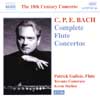Bach, CPE Flute Concertos
Elegant CPE Bach by Patrick Gallois, though the band is rather too modern in style
View record and artist detailsRecord and Artist Details
Composer or Director: Carl Philipp Emanuel Bach
Genre:
Orchestral
Label: Naxos
Magazine Review Date: 2/2003
Media Format: CD or Download
Media Runtime: 126
Mastering:
Stereo
DDD
Catalogue Number: 8 555715/6

Tracks:
| Composition | Artist Credit |
|---|---|
| Concerto for Flute and Strings |
Carl Philipp Emanuel Bach, Composer
Carl Philipp Emanuel Bach, Composer Kevin Mallon, Conductor Patrick Gallois, Flute Toronto Camerata |
| Sonata for Flute Solo |
Carl Philipp Emanuel Bach, Composer
Carl Philipp Emanuel Bach, Composer Patrick Gallois, Flute |
Author: Stanley Sadie
Although employed for more than 25 years by the most powerful of all flautists, Frederick II, Carl Philipp Emanuel Bach only once wrote a concerto specifically for the flute. But like his father he sometimes had the same music serve different soloists, and he made flute versions of several keyboard concertos (three have cello versions too) with such skill that not for a moment do they seem like arrangements.
Possibly Carl Philipp’s passionate invention doesn’t lend itself ideally to the concerto form, which demands, as it were, low voltage sections as well as fierce or brilliant ones; his ordinary orchestral style is so often fierce and brilliant. Listen to the opening of this CD: the orchestra starts off the A minor Concerto with a tremendous outburst of nervous energy that threatens to steal the flautist’s thunder. In fact, he has the flute enter with soft and slow music, and work up only later to greater speed and energy. Here and in other movements – the first of the D minor Concerto is a conspicuous example – Carl Philipp uses the same kind of intensely detailed thematic working in his accompaniments, dialogue passages and interjections that his father did in his concertos, though without quite the same kind of unifying effect.
This A minor Concerto is perhaps the most extreme example here of Carl Philipp’s unconventional style: the finale too is full of exclamatory, epigrammatic phrases and snatches of dialogue. There is fiery music in the D minor finale too, with rushing strings and dramatic, or melodramatic, pauses. The B flat work is more conventional in manner, more lyrical and shapely; there is a highly expressive flute line in its G minor Adagio, heavily reliant (as so often in Carl Philipp’s music) on sighing appoggiaturas, and a bustling, rather abrupt finale. Appoggiaturas abound, too, in the Largo of the A major work, a very intense piece (marked mesto, ‘sadly’) coming between two of Carl Philipp’s liveliest and most effective quick movements.
Patrick Gallois, principal flute of the Orchestre National de France, is a strong, accurate and rhythmic player, easily equal to the music’s technical demands, and with a good feeling for its expressive character, shading the slow movements sensitively. He plays the unaccompanied sonata in a rather improvisatory style. Kevin Mallon directs the Toronto Camerata with plenty of spirit and they play responsively. But I do think these concertos would sound better with period instruments; and Mallon would have been wise to forego the occasional spiccato bowing, which is alien to Carl Philipp, as surely is the pizzicato in the finale of the A minor work.
Possibly Carl Philipp’s passionate invention doesn’t lend itself ideally to the concerto form, which demands, as it were, low voltage sections as well as fierce or brilliant ones; his ordinary orchestral style is so often fierce and brilliant. Listen to the opening of this CD: the orchestra starts off the A minor Concerto with a tremendous outburst of nervous energy that threatens to steal the flautist’s thunder. In fact, he has the flute enter with soft and slow music, and work up only later to greater speed and energy. Here and in other movements – the first of the D minor Concerto is a conspicuous example – Carl Philipp uses the same kind of intensely detailed thematic working in his accompaniments, dialogue passages and interjections that his father did in his concertos, though without quite the same kind of unifying effect.
This A minor Concerto is perhaps the most extreme example here of Carl Philipp’s unconventional style: the finale too is full of exclamatory, epigrammatic phrases and snatches of dialogue. There is fiery music in the D minor finale too, with rushing strings and dramatic, or melodramatic, pauses. The B flat work is more conventional in manner, more lyrical and shapely; there is a highly expressive flute line in its G minor Adagio, heavily reliant (as so often in Carl Philipp’s music) on sighing appoggiaturas, and a bustling, rather abrupt finale. Appoggiaturas abound, too, in the Largo of the A major work, a very intense piece (marked mesto, ‘sadly’) coming between two of Carl Philipp’s liveliest and most effective quick movements.
Patrick Gallois, principal flute of the Orchestre National de France, is a strong, accurate and rhythmic player, easily equal to the music’s technical demands, and with a good feeling for its expressive character, shading the slow movements sensitively. He plays the unaccompanied sonata in a rather improvisatory style. Kevin Mallon directs the Toronto Camerata with plenty of spirit and they play responsively. But I do think these concertos would sound better with period instruments; and Mallon would have been wise to forego the occasional spiccato bowing, which is alien to Carl Philipp, as surely is the pizzicato in the finale of the A minor work.
Discover the world's largest classical music catalogue with Presto Music.

Gramophone Digital Club
- Digital Edition
- Digital Archive
- Reviews Database
- Full website access
From £8.75 / month
Subscribe
Gramophone Full Club
- Print Edition
- Digital Edition
- Digital Archive
- Reviews Database
- Full website access
From £11.00 / month
Subscribe
If you are a library, university or other organisation that would be interested in an institutional subscription to Gramophone please click here for further information.




